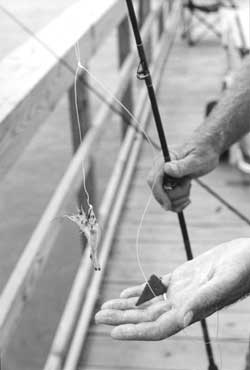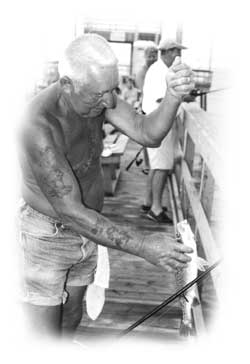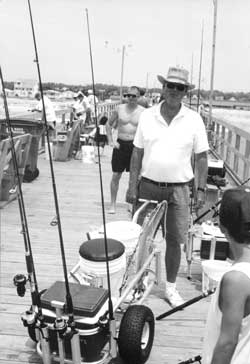
|
Stories from
the |
 |
Long Beach Pier is the unofficial gathering point for a group of anglers who enjoy each other and perhaps N.C.'s best surf fishing for speckled trout.
By CRAIG HOLT
Lewis Winecoff often is the first angler to reach Long Beach Pier each day.
The sun won’t have peeked over the horizon off Bald Head Island when he strides down the walkway timbers. In fact, he often arrives when most of the houses along the narrow spit of an island are dark, their inhabitants still finishing their night’s sleep.
It’s easy to see that Winecoff, 71, is a veteran saltwater fisherman. His face, arms, torso and legs are a sun-weathered brown.
He is the unofficial spokesman for about a half-dozen retirees who fish regularly from the pier, starting in mid-May and continuing through November.
When a fish is caught of undetermined ancestry, Winecoff usually is the first to identify it correctly. And he knows the legal minimum size for nearly every species that can be caught from the Atlantic Ocean off this pier, which has been destroyed and rebuilt numerous times, the last occasion in 1999 after it was turned into splinters by Hurricane Floyd, whose center roared ashore a few thousand feet up the beach.
But pier owner Tommy Thomes knows how lucrative the lure of this pier is to anglers. So he rebuilt it as quickly as he could at an expense of nearly $1 million (with the help of a Lloyds of London insurance policy).
He celebrated the pier’s reopening in June 2000 with a massive fireworks display.
Except for a few winter months when the water temperature drops into the 40s, the pier is open for business. And men, women and kids will come to test the waters and haul fish over the side.
 Flounder, king mackerel, Spanish mackerel, Virginia mullet
(whiting), spots, bluefish, pompano and puppy drum are taken from the green
waters that surge around Long Beach Pier.
Flounder, king mackerel, Spanish mackerel, Virginia mullet
(whiting), spots, bluefish, pompano and puppy drum are taken from the green
waters that surge around Long Beach Pier.
And unusual catches abound. Statesville’s Mickey Gaither landed a 66-pound black drum that had hit a spot rig on April 14. It took long gaffs wielded by three other anglers and a landing net to haul the brute ashore.
But this June day, Winecoff is rigged for speckled trout. Long Beach Pier, located about midway between the east and west terminuses of Oak Island, provides excellent speckled trout fishing nearly all year long.
“We come as early as we can stand and stay as late as we can stand it,” said 66-year-old “Papa” John Davis, a Charlotte native who worked for BellSouth in Raleigh for 34 years before migrating to Oak Island nine years ago.
“It used to be that the earlier you got out here, the better the speckled trout fishing,” Davis said. “But lately, (the time) doesn’t seem to make much difference. If the trout are in here, you just have to be here when they decide to start biting.”
The specks don’t wait for winter and the dropping of the mercury to flood out of the creeks behind Oak Island, the Cape Fear River or Lockwood Folly Inlet. Speckled trout are caught nearly all season at this 988-foot-long structure, which was rebuilt with “reef balls,” concrete domes with holes cut in them, placed around many of the pilings.
“We’ve got 66 reef balls (under the pier),” said pier worker Ronnie Bullard, who usually finds time to fish for king mackerel a few days each week, starting in the spring and finishing in the fall. “(The reef balls) provide good habitat for baitfish and seem to draw in lots of fish.”
The reef balls are split, 33 on each side of the pier, beginning at the cleaning sink to the ‘T’ at the pier’s end.
Holes were drilled in the top of the pier’s reef balls, so they could be slid over the pilings after the wooden supports were pile-driven into the ocean floor.
Trout fishing always has been good at Long Beach Pier, but now it may be even better because of the reef balls. These concrete domes also attract other species, such as flounder. In fact, famed Southport flounder angler and guide Jimmy Price calls them “flounder motels.”
But speckled trout also seem to like them. They’re caught at the pier starting in the early spring and running through the late fall.
Davis was the second angler on the pier to join Winecoff, who was born in Statesville, raised near China Grove and moved to Long Beach from the shores of High Rock Lake in 1992.
Then Buck Malcolm, a local U.S. Postal Service employee, came striding out from the pier house, pushing his rod cart. Carl Bedsole, 63, a tall, lanky Fayetteville native who spent 38 years in Danville, Va., as a Dow Corning worker, soon joined them, followed by Mt. Airy native Roger Cates, an anesthetist at nearby Dosher hospital. Former Charlotte resident Tommy Connell, an electrician who moved to Oak Island to get away from the Queen City’s traffic for better duck hunting and discovered saltwater fishing, also is a member of the club, along with 65-year-old Tom Keeler, a retired Northwest Airlines employee.
The best bait for specks at the pier — and elsewhere — is live shrimp.
Individuals in the group take turns catching shrimp with a cast net in order to beat the cost of buying live bait. They keep the trout in enclosed pens. Several of the guys have pens next to piers behind their homes, which border Davis Creek.
“All the guys get bait, then we keep ‘em at one guy’s house and share them,” Winecoff said.
There’s a shared and rotating responsibility to bring food, too, especially for breakfast.
“One guy will bring ham biscuits, another sausage biscuits,” said Winecoff, who started fishing at Long Beach in 1985, bought a home on 43rd St. in ‘86, then moved permanently to Oak Island in ‘91.
“Trout fishing usually is
good here starting in May and running all through the summer and into the fall.
But you can catch fish here all year long. It’s been especially  good this year since they reopened the pier in June and put
in those flounder motels.”
good this year since they reopened the pier in June and put
in those flounder motels.”
There are a couple of techniques used on the pier to catch speckled trout.
Most of the pier’s trout-fishing regulars use spinning reels and medium-action rods with 12-pound-test monofilament line and 20-pound-test leader. They fish on the bottom, while one uses a “popping” rig for topwater action.
As for terminal tackle on the bottom rigs, some prefer a 2-ounce barrel weight and some use a 3-ounce bank or pyramid sinker. About 18 inches above the sinker, the bottom-rig anglers tie on a foot-long dropper line with No. 6 gold treble hooks. Then they impale a live shrimp just behind the dark spot with one of the trebles.
“Hooking him there won’t kill him,” Winecoff said.
“Sometimes we catch flounder, too, and whiting and blues (with shrimp).
“I like to use 20-pound-test leader because if it’s any lighter, if a bluefish hits this rig, it will pop the leader,” Davis said.
Some anglers tie two dropper lines, doubling up on hooks and shrimp to increase their chances of getting bit.
The casting technique is simple — make sure no one is behind you, if you’re casting overhand, flip the spinner’s bale, pinch the line against the section of rod just above the reel to keep it from releasing, then heave the lead weight and shrimp off the pier’s side toward the ocean as you release the line with your finger.
Some anglers use an underhanded pendulum-style flip, pointing the rod tip toward the water as they lean over the guard rail. They swing their terminal tackle back underneath the pier (but not so far as to hit a support beam), then snap it forward and out as they release the line.
This technique takes a little practice as novices tend to hold their line too long, sending their rigs flying straight up like a rocket, instead of out and away from the pier.
Long Beach Pier anglers who use the underhanded flip also must be wary of steel cables stretching from piling to piling to add support. The cables underneath the pier’s boardwalk are enveloped in a gauzy haze of fishing line, as if a nest of a million mutant spiders had been busy spinning monofilament webs for months.
But Winecoff and his veterans never seem to get their lines caught.
Winecoff, who uses Seastrike and Quantum rods and Quantum Quick Fire and Great White reels, said he enjoys the fellowship of being outside with his friends as much as the fishing.
And, as usually happens, a fellow who isn’t intense about catching fish often lands more than anyone else.
“I just love it out here,” he said. “I give most of my fish away, or we will get together at somebody’s house and have a fish fry.”
“One day we gave some guy from Maryland 17 trout and 10 whiting,” Connell said. “His crowd fixed some of ’em that night, and he came back and said those fish were delicious.”
Winecoff said Long Beach Pier may be unique among N.C. piers.
“You can catch fish year-round here,” he said. “And it doesn’t seem to matter a lot which tide. They may bite at low, high or mid-tide, although I’ve noticed that it may be just a touch better at low tide.”
 Bedsole said he uses a 5 1/2-foot stiff rod with a limber
tip.
Bedsole said he uses a 5 1/2-foot stiff rod with a limber
tip.
“I like the stiff rod so you can lift the fish straight up out of the water,” he said.
“You need a limber tip so you can see the trout when he strikes, but you want a rod with a stiff backbone so you can lift the fish up over the side.”
Bedsole, an Elon College graduate, said he’d rather lift a fish than have someone try to land it in a circular landing net “because I’ve seen too many fish lost because either the guy holding the rod or the guy with the net didn’t know what he was doing.”
One of Bedsole’s techniques is to use a double-loop dropper for tying on treble hooks.
“About 3 feet above my 2-ounce pyramid sinker is where I tie on a knot with the dropper and my hook,” he said. “That’s so you don’t have any swivels or anything else to distract a trout from the shrimp. If the shrimp are small, I tie two droppers and use two shrimp at a time.”
One of the pier’s top trout anglers eschews the tried-and-true bottom rig in favor of a top-water popping outfit, often used by shallow-water anglers who chase trout in the sounds behind the Outer Banks.
“(Roger Gates) catches more trout, consistently, than any of us,” Connell said.
“This float rig is heavier than most, but that lets me throw it into the wind better,” said Gates, who has been catching trout from Long Beach Pier since the early 1970s.
He uses a 2-foot leader with No. 6 gold treble hooks to hold his shrimp. He uses 15- to 17-pound-test line and winches his trout up over the side, just as Bedsole does.
“I’ve seen an awful lot of trout lost at the landing net,” Gates said.
“I always use a hair lighter line for my leader so if a big skate (stingray) or a ladyfish hits my shrimp, it’ll break the line, but I won’t lose my entire rig.”
He ties a slip knot above his popper so that he can adjust the depth his shrimp will be in the water below his float.
Gates tosses his rig as far out as he can with an overhand cast, pumps his rod then retrieves line, allowing the shrimp to rise and fall underneath his float. He winds in the rig slowly, not as quickly as a bass angler would work a Carolina rig but slower than most anglers would work a Zara Spook.
Most of his trout hit the shrimp as it’s falling.
“I’ll catch more using this rig than anyone else on the pier,” he said with a quiet smile.
Gates said he had discovered the popper rig when he fished for speckled trout at Morehead City.
“It’s very popular up there,” he said.
Gates said his best speck was a 4 1/2-pounder, but he had seen some 6-pounders caught at Long Beach Pier.
Some of the specks caught at Long Beach can run to trophy size.
Davis said his best was 3 1/2 pounds “but my son, Bart, who lives in Charlotte, landed a 5-6 last year.”
Davis said a 6-14 had been taken in August.
“But you’ve got to pick your times (to fish),” he said. “The weather doesn’t always cooperate. If (the water’s) muddy, you’re wasting your time.
“The best wind for trout fishing here is a gentle southeast or southwest wind. It’s usually southwest here when the fishing’s really good.
“You see the jellyfish (being blown toward the shoreline), and then you know the wind’s right for trout.”
But catching trophy trout isn’t the Long Beach trout club’s main purpose anyway — they enjoy sharing time, cookouts, ribbing each other and playing practical jokes as much as they do catching trout, which they do with more regularity than anyone else at the pier.
Winecoff came home from a night out at one of the local social clubs and found his yard suddenly had sprouted a flock of plastic pink flamingoes.
“I’ve got a pretty good idea of who did it,” he said, nodding toward his compadres, who just laughed. “They know those birds will turn up in their yard one night.”
Any member of the Long Beach Trout Club who awakens to find pink plastic birds in his yard, or even on his roof, will accept his fate. By fishing, each has become accustomed to fickle fortune. After all, like landing speckled trout at Long Beach Pier, it’s all in fun.
|
Copyright © 1999-2003 North Carolina Sportsman, Inc. All rights reserved. Please contact our WebMaster if you experience problems with the website. |